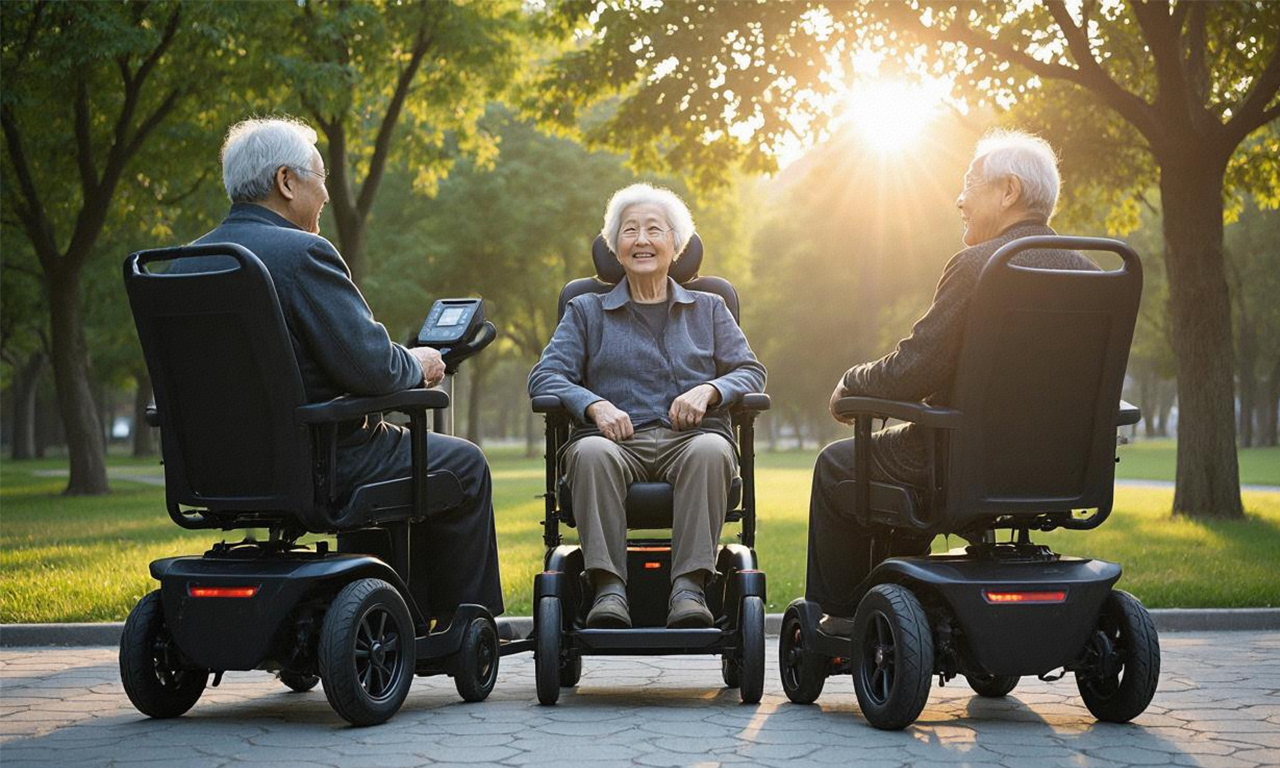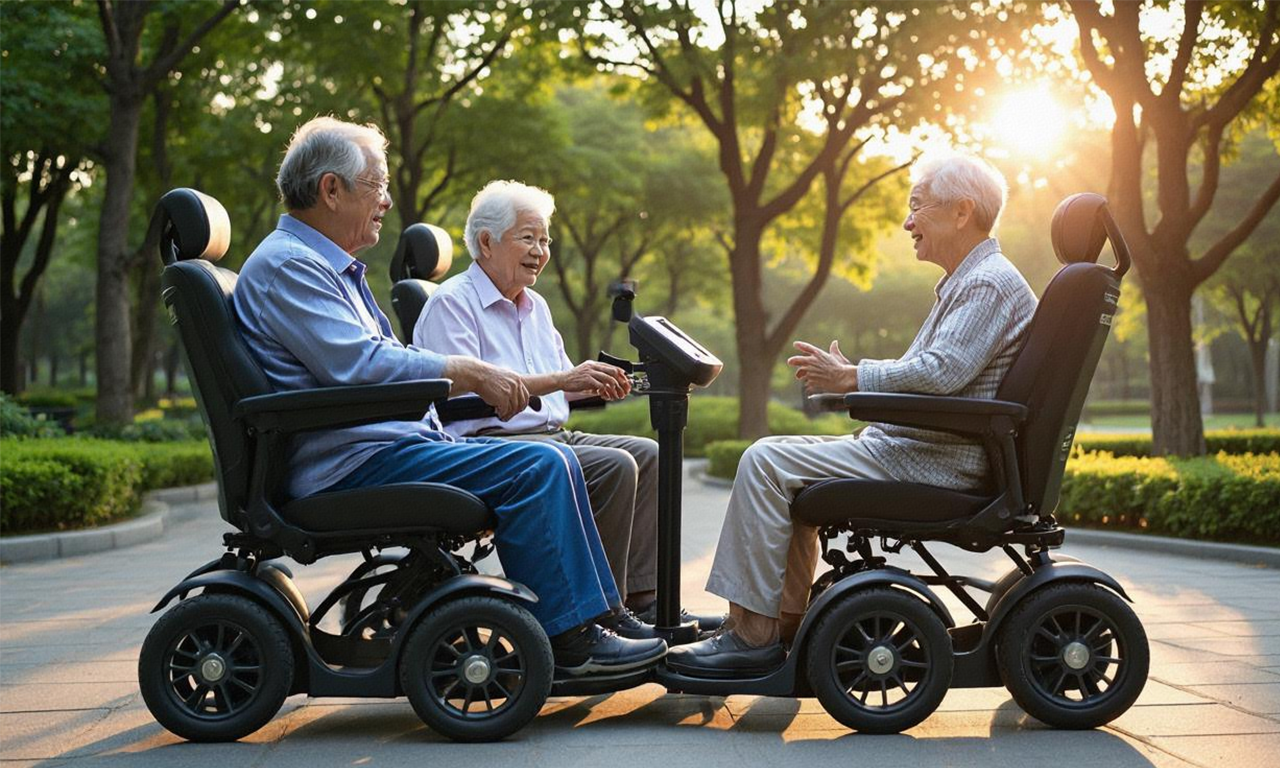Unveiling the Secrets of Electric Wheelchair Batteries: Scientific Power Configurations from Portable to High-Performance
As the first rays of morning sunlight fell, Li, comfortably seated on his portable power chair, steadily exited the neighborhood gates, heading to the park for chess and conversation with his elderly friends. Powered by two lead-acid batteries hidden beneath the seat, this electric wheelchair had been his faithful companion for four years. He often remarked, "This chair is my second pair of legs, and the batteries are its heart. Understanding them is key to going farther."

1. The Powerhouse of Electric Wheelchairs: Decoding Battery Quantity
The core power of an electric wheelchair comes from its battery pack. The number of batteries typically ranges from 1 to 4, a number determined by meticulous engineering calculations:
-
Portable Power Chair / Power Wheel Chair:
- Configuration: Mainstream models use 1 or 2 batteries.
- Data Support: For example, the Drive Medical Scout Travel Power Wheelchair features a single 24V, 12Ah lithium battery weighing only 3.8kg (8.4 lbs). The Pride Mobility Go-Go Folding Portable Power Chair commonly uses two smaller 12V, 10-14Ah lead-acid or AGM batteries, providing a total range of 10-16 km (6-10 miles).
- Key Considerations: These batteries are meticulously designed for minimal weight, with individual units weighing between 2.5-4kg (5.5-8.8 lbs), making them easy for users or caregivers to remove and charge. Quick-release mechanisms allow for battery removal in less than 10 seconds, a crucial factor enabling the chair's rapid folding time (often <30 seconds) and keeping overall weight between 22-35kg (48-77 lbs).
-
Standard Electric Wheelchair / Electric Automatic Wheelchair:
- Configuration: The vast majority of standard indoor/outdoor models come equipped with 2 deep-cycle batteries.
- Data Support: Models like the Invacare® TDX® SP2 typically use two 12V, 35-50Ah AGM or lithium-ion batteries (totaling 24V). For a user weighing 100kg (220 lbs), a full charge offers a range of 15-25 km (9-15 miles). Average battery weight ranges from 7-9kg (15-20 lbs) per unit, with cycle lives around 300-500 cycles (lead-acid) or 800-1200 cycles (lithium).
- Key Considerations: The balanced design of two batteries provides the low center of gravity needed for stability. The battery capacity matches the typical power range of wheelchair motors (250W-450W), ensuring sufficient power for daily activities while keeping manufacturing costs manageable.
-
Outdoor High-Performance Electric Wheelchair:
- Configuration: Designed for complex terrain and long distances, these chairs are standardly equipped with 4 batteries (typically running 24V or 48V systems).
- Data Support: Premium models like the Quantum® Q6 Edge 2.0 often use four 12V, 50Ah+ AGM batteries (forming a 48V system), sustaining travel over 35-50+ km (22-31 miles) on rough terrain. Lithium solutions, such as the Whill Model C2, utilize custom high-capacity packs (e.g., 48V, 20Ah+) for even greater range. These systems support powerful motors (typically **>400W**, peaking around 800W) and features like hill descent control, enabling users to tackle inclines exceeding 10 degrees.
- Key Considerations: Four batteries provide the necessary high voltage (48V) or extra-large capacity to drive more potent motors, delivering the high torque needed to conquer steep slopes (up to 10-15 degrees or more) and uneven surfaces. They also guarantee significantly longer range than portable chairs, fulfilling the desire for freedom of exploration among outdoor enthusiasts.
The table below details typical battery configurations for each category:
| Comparison Factor | Portable Power Chair | Standard Electric Wheelchair / Electric Automatic Wheelchair | Outdoor High-Performance Wheelchair |
|---|---|---|---|
| Number of Batteries | 1 or 2 (2 more common) | ★★★ 2 (Most common config) | ★★★★ 4 (Standard config) |
| Battery Type | Predominantly Lithium (>80%) | AGM (~65%) / Lithium (Increasing Share) | AGM (Dominant) / Lithium (High-End) |
| Range (Single Charge) | 10-16 km (6-10 miles) | 15-25 km (9-15 miles) | 35-50+ km (22-31+ miles) |
| Weight per Battery |
2.5-4 kg (5.5-8.8 lbs) (Ultra-lightweight) |
7-9 kg (15-20 lbs) (Standard Design) |
12-15 kg (26-33 lbs) (High-Density Config) |
| Charging Time |
2-4 hours (Fast charging prominent) |
6-8 hours (Standard charging) |
8-10 hours (Requires higher-power charger) |
| Intended Use Scenario | Short distances, home use, vehicle transport | Daily routines, commuting, travel on level surfaces | Rough terrain, long distances, challenging weather |
2. Delving into the Core: Electric Wheelchair Battery Science
1. Voltage System: The Foundation of Energy Transfer
- 12V, 24V, 36V, 48V: These represent the base voltage used to drive the motor. Higher voltage delivers more power (Power P = Voltage V x Current I) for the same current, enabling stronger motors or reducing energy loss during high-current transmission.
- Portable Power Chairs & Voltage: Most utilize a 24V system (whether single or dual battery). Their high-energy-density lithium batteries mean a single 24V unit can power the entire system.
- Standard Wheelchairs: Primarily use 24V systems (two 12V batteries in series).
- Outdoor Wheelchairs: 48V systems represent the performance benchmark, formed by four 12V batteries in series.
2. Battery Type & Technological Evolution
The mobility revolution in electric wheelchairs is significantly driven by battery advancements:
-
AGM (Absorbent Glass Mat):
- Market Position: Holds approximately 70% market share due to mature technology, reliable sealing (leak-proof), and cost-effectiveness.
- Cycle Life Data: High-quality AGM batteries achieve around 400 deep cycles (discharged to 50% capacity). Users typically get 2-3 years of regular use.
-
Price Range: A single 12V 35Ah AGM battery costs approximately
90-130 USD.
-
Lithium-Ion Batteries:
-
Revolutionary Advantages:
- Weight Reduction: Same capacity, lithium batteries weigh only one-third to half as much as AGM. This allows portable power chairs to keep total weight under 30kg (66 lbs).
- Energy Density: Lithium can reach 150-200 Wh/kg, far exceeding AGM's 30-50 Wh/kg. This provides longer range for the same physical size.
- Extended Lifespan: Cycle life vastly surpasses AGM. Quality lithium batteries achieve 800+ deep cycles (discharged to 80% capacity), potentially lasting 5+ years.
- Charging Efficiency: Support fast charging. Many models can reach 80% charge in 1-2 hours.
- Market Penetration: Already exceed 80% share in the portable wheelchair market and are rapidly increasing in mid-to-high-end standard and outdoor models.
-
Price Range: Costs remain higher. An equivalent battery unit (e.g., 24V 20Ah) costs approximately
500-800 USD, though prices are decreasing annually by 5-8%.
-
Revolutionary Advantages:
3. Energy Consumption Logic of the Drive System
Every electric automatic wheelchair requires a stable power supply:
- The Motor is the Power Hungry Core: During normal use, a 250W motor draws 10-15A (24V system) or 5-8A (48V system). Current can surge 2-4 times during hill climbing or on rough terrain. Batteries must deliver this high instantaneous power without damage.
- The Controller: The "brain" for precise power management, distributing DC power from the battery to the motor as needed. While its own consumption is low (<0.5A), it significantly impacts overall system efficiency.
- Auxiliary Systems: Functions like powered seats (>50W), pressure-relieving cushions (>20W), and high-power lights (>5W) accelerate battery drain. Portable wheel chairs often have fewer features, consuming less power.
4. Key Variables Impacting Range
Real-world battery range is highly variable due to:
- User Weight & Load Data: An increase of 20kg (44 lbs) in user weight can reduce average range by 10%-15%.
- Terrain & Incline Data: Frequent travel on 3-5 degree slopes can shorten range by 15%-25% compared to flat ground. Consumption spikes dramatically on **>8 degree** inclines.
- Ambient Temperature Data: Below 0°C (32°F), AGM capacity can diminish by 30%-50%. High temperatures (>35°C / 95°F) accelerate aging.
- Driving Habits & Speed Data: Sustained top speed drains 20%-40% more power than moderate speeds with intermittent use. Frequent starts and stops also increase consumption.
5. Charging Efficiency & Battery Longevity Science
Proper charging is paramount to battery longevity:
- Smart Chargers: Modern wheelchairs universally use smart chargers with CC-CV-Float multi-stage charging for precise management and overcharge prevention.
-
Charging Speed Data:
- Portable Power Chair: Lithium batteries often pair with 3A-5A fast chargers, achieving full charge in 2-4 hours.
- Standard Wheelchair: AGM batteries typically use 5A-8A chargers requiring 6-10 hours.
- Outdoor Wheelchair: High-capacity systems may need 10A+ chargers, taking 8-12 hours.
- Dangers of Deep Discharge: Frequently draining batteries completely (deep discharging) is especially harmful to AGM, potentially damaging them permanently and causing 5%-10% immediate capacity loss. While lithium tolerates it better, avoid regularly discharging below 20%.
-
Storage Voltage: For long-term storage (weeks/months):
- AGM Batteries: Maintain 12.6V-12.8V (per 12V unit).
- Lithium Batteries: Store at 40%-60% state of charge.
3. Cutting-Edge Trends: The Future of Power Solutions
Technological evolution is propelling electric automatic wheelchairs into a new era:
-
Fast-Charging Revolution:
One-hour fast charging solutions for portable power chairs are established. 30-minute 50% charge capabilities are becoming standard in high-end models, significantly reducing "range anxiety". -
Modular & Customizable Energy Packs:
To meet diverse travel needs, advanced chairs support swappable batteries and parallel expansion. Users can add hot-swappable external packs, theoretically extending range to 70-100 km (44-62 miles), enabling long excursions or short trips. -
Permanent Magnet Motor Drive Advancements:
48V systems combined with high-efficiency Permanent Magnet Synchronous Motors (efficiency >90%) are becoming the gold standard in top-tier outdoor wheelchairs. These motors offer 15%-25% better efficiency than traditional types, enhancing performance without demanding more from the batteries. -
Regenerative Braking Systems:
Capturing energy during descent and braking can realistically boost range by 8%-12%, with particularly significant benefits in hilly regions.
The true transformation of an electric wheelchair from a mobility aid to wings of freedom hinges on those silent energy units nestled beneath the seat – they dictate the distance one can traverse rugged paths and the courage to conquer steep ascents. Understanding the quantity, type, and science behind these power cores means every charge holds the potential for greater distances, extending the tangible scope of barrier-free living. Where technology meets human need, the wheelchair elevates beyond a mere tool: it becomes a guardian of dignity. For every ampere flowing empowers not just a motor, but the unwavering determination for independence and an unyielding declaration for the future.

Appendix: Authoritative Q&A on Electric Wheelchair Batteries
Q1: My portable power chair suddenly has half its usual range. Does this mean one battery is faulty? (Single battery model)
A: On a single-battery portable power chair, a sudden, significant range decrease is highly likely due to a severe problem with that battery. Common causes include:
- A failed cell causing overall voltage collapse (check open-circuit voltage with a multimeter; be alert if >20% below nominal).
- Deep discharge damage (avoid discharging below 20%).
- Physical battery aging (>800 cycles for lithium; 5+ years old).
Recommendation: Perform a full charge with the original charger and test actual range. If less than 60% of specification, or if charging is abnormal (too fast/green light premature/excessive heat), contact an authorized service center immediately for battery diagnostics and replacement.
Q2: What are the risks of using a standard dual-battery electric wheelchair long-term with only one battery?
A: Severely hazardous! Strictly prohibited! Dual-battery systems (series for 24V) rely on voltage balance. Using only one battery:
- Causes the controller to malfunction or fail completely due to insufficient voltage (only 12V instead of 24V).
- Forces the motor to draw excessive current (potentially 10x+ normal), risking overheating and winding burnout.
- Can cause the single battery to overload and discharge dangerously, leading to internal shorts or thermal runaway.
If one battery fails, rendering the chair inoperable, both batteries must be replaced simultaneously (or with a perfectly matched new pair).
Q3: How should batteries be maintained on a high-performance electric automatic wheelchair with four batteries?
A: Complexity demands meticulous care:
- Monthly Voltage Checks: Measure each battery's voltage with a multimeter (after resting 6+ hours). Voltage deviation within a system must be ≤0.2V (for 12V units). Exceeding this warrants professional inspection.
- Periodic Full Charge/Discharge Calibration: Quarterly: Fully charge → Use consistently until low-battery warning (~30% remaining) → Fully recharge. This calibrates the battery management system (BMS).
- Temperature Protection: Avoid use/charging below -10°C (14°F) if possible. Avoid direct sunlight/charging in temperatures exceeding 35°C (95°F). Users in very cold regions should use low-temperature specific batteries.
- Storage Protocol: Before long-term storage, charge batteries to approximately 50% (~12.4V per 12V battery). Disconnect the main harness connector. Store in a cool, dry place (0°C-25°C / 32°F-77°F).
Q4: Can I upgrade my standard electric wheelchair from lead-acid (AGM) to lithium batteries myself?
A: Technically feasible but requires thorough assessment! Before swapping:
- Ensure new lithium pack output voltage matches the original system precisely (e.g., both 24V).
- Verify controller compatibility with lithium chemistry (charging profile differs significantly).
- Check physical fit within the battery compartment (lithium is often smaller).
-
Must replace the charger with a dedicated lithium charger!
Improper installation can lead to charging hazards, BMS lockout, or damage. Strongly recommend having a qualified technician or authorized dealer perform the upgrade, ensuring BMS integration with the chair. Improper modifications typically void manufacturer warranties. Damage due to DIY efforts is not covered.





Leave a comment
This site is protected by hCaptcha and the hCaptcha Privacy Policy and Terms of Service apply.